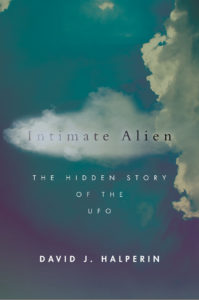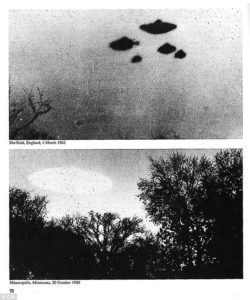Intimate Alien: The Hidden Story of the UFO
A book excerpt with an introduction by the author
In March of this year, Stanford University Press published my book Intimate Alien: The Hidden Story of the UFO in its “Spiritual Phenomena” series. The book was nearly sixty years in the making. As a teenager who was fascinated by UFOs, I dreamed of writing a book where I would definitively solve what I then called “the flying saucer mystery.” As a scholar of religion I have come to understand the path along which that solution is to be found. UFOs are visitors, not from outer space, but from our own inner space—home to enough alienness to fill a universe. That is what is at the heart of Intimate Alien.
The following excerpt comes from the book’s introduction.
***
This is a book about UFOs. Most such books try to make a case for UFOs’ physical existence as visitors from other planets or possibly other dimensions. A much smaller but still substantial chunk of the literature will argue that they’re a sustained absurdity, a mishmash of honest human mistakes compounded by dishonest ones. Those are the two main currents of thought on the subject: that of the “believers” and that of the “debunkers.”
 I’m writing as someone with a particular investment in the topic. Back in the 1960s, I was a teenage “UFOlogist.” I grew up to be a professor of religious studies whose main research interests have been religious traditions of heavenly ascents and otherworldly journeys. I’ve worked with the visions of the Biblical prophet Ezekiel, particularly the first and strangest of them: the vision of the “living creatures” and the wheels that sometimes rested on the ground, sometimes flew in the air. In other words, UFOs.
I’m writing as someone with a particular investment in the topic. Back in the 1960s, I was a teenage “UFOlogist.” I grew up to be a professor of religious studies whose main research interests have been religious traditions of heavenly ascents and otherworldly journeys. I’ve worked with the visions of the Biblical prophet Ezekiel, particularly the first and strangest of them: the vision of the “living creatures” and the wheels that sometimes rested on the ground, sometimes flew in the air. In other words, UFOs.
I don’t believe, nor do I debunk. This book will advocate for a third way.
My starting point: UFOs are a myth. But in saying this, I don’t mean what you might think I do.
A little over fifty years ago, two books appeared within a few years of each other bearing almost identical titles—and almost opposite messages. One was The World of Flying Saucers: A Scientific Examination of a Major Myth of the Space Age, by astrophysicist Donald Menzel. The other was Flying Saucers: A Modern Myth of Things Seen in the Skies, by psychologist Carl Jung. Menzel, the most vocal and prominent UFO skeptic of the era, used myth as people often do, to mean “bunk, nonsense,” or at least something that isn’t true. For Jung the word had nearly the opposite meaning: not falsehood, but the profoundest truth of all.
Jung’s writings are notoriously dense and difficult. Flying Saucers, the last book he published before his death in 1961, is no exception. How valiantly I struggled through it as a budding UFOlogist, just past my thirteenth birthday! (It was one of three books on UFOs in our local library.) Of course I could make neither head nor tail of it. I hadn’t a clue about the assumption on which it rests: that our ordinary awareness is an eggshell boat on the vast roiling sea of the unconscious, the deeper (“collective”) levels of which we share with all other humans.
These depths, accessed through individual dreams and the collective dreams called myths, aren’t always bright or benign. But they’re holy, or “numinous,” as Jung liked to say: uncanny, transcendent, timeless. When a myth takes visible form, when it’s projected into the sky as a flying disk (or “mandala,” as Jung would say), that’s a major event, akin to what our ancestors might have called a vision of God.
 All this is controversial, hardly less so than UFOs themselves. I find Jung’s models just plausible enough that I’m prepared to use them as tools if they make sense of the otherwise unintelligible. When other tools work, I also take them up gladly. The insights of twenty-first century cognitive psychologists into the evolutionary grounding of our disposition toward myth add depth and poignancy to our human inclination to trust what the Bible calls “the evidence of things not seen” (Hebrews 11:1). The timeworn Freudian dictum that “every memory returning from the forgotten past … puts forward an irresistible claim to be believed, against which all logical objections remain powerless” turns out to shed unexpected light on some of the thornier riddles of the UFO. None of these approaches can be ignored.
All this is controversial, hardly less so than UFOs themselves. I find Jung’s models just plausible enough that I’m prepared to use them as tools if they make sense of the otherwise unintelligible. When other tools work, I also take them up gladly. The insights of twenty-first century cognitive psychologists into the evolutionary grounding of our disposition toward myth add depth and poignancy to our human inclination to trust what the Bible calls “the evidence of things not seen” (Hebrews 11:1). The timeworn Freudian dictum that “every memory returning from the forgotten past … puts forward an irresistible claim to be believed, against which all logical objections remain powerless” turns out to shed unexpected light on some of the thornier riddles of the UFO. None of these approaches can be ignored.
In his emphasis on the gravity of myth, on the force of its claim to our attention and respect, Jung marks out the path I’ve chosen to travel. As “myth,” UFOs aren’t nonsense. They’re about the furthest thing from “bunk” that can be imagined. They’re a creation of the space age and yet as real, as vital, as universal as any myth that has spoken from our unconscious since the dawn of prehistory. The central question that needs to be asked about them isn’t, What are they? or Where do they come from? or, conversely, How can any sensible person believe such rubbish? The question is, What do they mean?
Should we care?
Grant that UFOs are a myth. Or even more: a full mythology, complex and ramified, stretching into areas of experience that seem far removed from objects in the sky, its true subject not space aliens but who we are as human beings. Yet there’s a sharp difference between UFOlogy and the great mythical systems of the past, such as that of the Greeks. Those mythologies were the consensus beliefs of entire cultures. UFOs seem doomed to a shadow existence on the fringes of ours.
They may have “conquered the world,” as the title of a recent book on UFOs puts it, but it’s a hollow sort of conquest. More than seventy years after their emergence, they show no sign of going away, but neither do they show the smallest capacity to move into the mainstream. They remain the province of the eccentric, the discontented, and the deluded, if at times the wildly gifted. Can a mythology of losers and misfits be of any significance for the rest of us?
The following reply suggests itself: Who says the rest of us are nonmisfits, nonlosers? “Fitting” in this life is a painful, difficult, always inadequate process, and at the end each and every one of us loses that which our whole being strains most terribly to keep. We point a mocking finger at the “losers,” the “kooks,” the marginal. Beneath our laughter is an awareness that we’re not really so different. What we see in those “losers” is here in all of us.
“The words of the prophets are written on the subway walls / And tenement halls,” Simon and Garfunkel sang a generation and a half ago. As a scholar of religion, I’ve been well served by Freud’s insight that it’s often the jumbled and bizarre, the disreputable and seemingly senseless that’s the pathway into our deepest secrets. A mythology of the fringe is not to be presumed negligible, especially when it’s as plugged into the wider society as this one is. From the hinterlands, UFOs cast their shadows across our culture.
 Ever hear of Roswell, New Mexico? Area 51? Chances are you have, even if you’re not sure exactly what’s supposed to have happened at Roswell or what Area 51, the top-secret tract of Nevada desert that’s seen some of the Cold War’s most horrific weapons tests, has to do with UFOs. When Barack Obama declared in 2013 that “when you first become president, one of the questions that people ask you is, ‘What’s really going on in Area 51?’” of course he was joking. But the joke would have fallen flat if there’d been no truth in it that his audience could understand and appreciate. Hillary Clinton may have been less than serious in promising a New Hampshire reporter that if elected in 2016 she’d “get to the bottom” of UFOs, sending a “task force” to Area 51. But would she have said such things if she hadn’t calculated that “courting the UFO believer vote,” as one web headline put it, would resonate with a substantial chunk of her constituency? And when some cartoon or advertisement depicts a creature with a face shaped like an old-fashioned light bulb and just as hairless, dominated by two slanted, enormous, solid-black eyes, do you need to be told it’s an alien?
Ever hear of Roswell, New Mexico? Area 51? Chances are you have, even if you’re not sure exactly what’s supposed to have happened at Roswell or what Area 51, the top-secret tract of Nevada desert that’s seen some of the Cold War’s most horrific weapons tests, has to do with UFOs. When Barack Obama declared in 2013 that “when you first become president, one of the questions that people ask you is, ‘What’s really going on in Area 51?’” of course he was joking. But the joke would have fallen flat if there’d been no truth in it that his audience could understand and appreciate. Hillary Clinton may have been less than serious in promising a New Hampshire reporter that if elected in 2016 she’d “get to the bottom” of UFOs, sending a “task force” to Area 51. But would she have said such things if she hadn’t calculated that “courting the UFO believer vote,” as one web headline put it, would resonate with a substantial chunk of her constituency? And when some cartoon or advertisement depicts a creature with a face shaped like an old-fashioned light bulb and just as hairless, dominated by two slanted, enormous, solid-black eyes, do you need to be told it’s an alien?
“Thirty-six percent of Americans, about 80 million people, believe UFOs exist,” ABC News announced in June 2012 on the basis of a study by the National Geographic Channel. Nearly four-fifths of those polled, moreover, thought the government was hiding something about UFOs. These figures, which can’t have escaped the shrewd Ms. Clinton, were in line with earlier surveys that suggest that an even larger percentage of Americans—something like half—believe in UFOs. This is not exactly a “fringe.” Not only are the UFOs embedded in our cultural awareness. In very considerable numbers, we seem to think they’re real.
Yet not to be taken seriously. In our culture UFOs are funny; those who see them, funnier; and those “fringe” types for whom they’re a significant part of reality, the funniest of all. This is a paradox, one of many to be explored in this book. Why does the UFO-themed Close Encounters of the Third Kind gross over $300 million and become a cinema classic, while organizations dedicated to UFO research languish for want of public interest? Why, in the words of folklorist Thomas Bullard, are UFOs “at once so popular and so despised?”
The resolution of the paradox lies in the slippery, elusive, “as-if” quality of UFO belief, which needs to be explored if we’re to understand its significance. This is a peculiar sort of belief, not quite what it appears on the surface. I should know. I once held it myself.
David J. Halperin was a teenage UFOlogist, afterward a Professor of Religious Studies. He trained in Semitic and classical languages at Cornell University, and received his Ph.D. in Near Eastern Studies in 1977 from the University of California at Berkeley. From 1976 until his retirement in 2000, he taught the history of Judaism in the Religious Studies Department at the University of North Carolina, Chapel Hill. He is the author of five books on Jewish mysticism and messianism and one novel, Journal of a UFO Investigator, published in 2011 by Viking Press and translated into Spanish, Italian, and German. He blogs about UFOs, religion, and other subjects dear to his heart at www.davidhalperin.net.